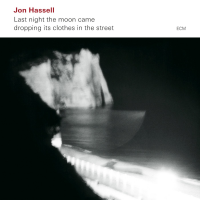Home » Jazz Articles » Extended Analysis » Jon Hassell: Last night the moon came dropping its cloth...
Jon Hassell: Last night the moon came dropping its clothes in the street
It's no hyperbole to suggest that without Jon Hassell there'd be no annual Punkt Festival, nor would artists like Arve Henriksen, Nils Petter Molvaer and David Sylvian (amongst others) be quite the same. Hassell's innovations in the areas of live sampling, real-time soundscaping and a musical confluence that he refers to as "The North and South of You"—meaning the cerebral/intellectual versus the physical/sensual—have inspired so many artists since his early collaborations with legendary producer/ambient music forefather Brian Eno that, while his name may not be as well-known as it should, it's an undeniable truth that the entire musical world would be a very different place without him.
While Hassell has made some detours along the course of his career, what's perhaps most remarkable is that his vision was so well-formed from the beginning, that it's indeed possible to draw a straight line from early, seminal albums including Fourth World Vol. 1: Possible Musics (E.G. 1980) and Power Spot, through to Last night the moon came. The technology has improved, better allowing him to translate what he hears into reality, but so many of the markers from the beginning remain. Hassell's lush, inescapable tone—part embouchure, part electronics—combines spare, thoughtful melodies with an unadorned and pure sensuality. The soundscape he creates is equal parts musical conception and improvisational acumen—in this case, with the participation of a large group of players including long-time bassist Peter Freeman, North African virtuoso violinist Kheir Eddine M'Kacich, and Norwegian newcomers Jan Bang (live sampling) and Eivind Aarset (guitar).
At the core of the album are its two longest tracks, easily summarizing Hassell's electronics-drenched multidisciplinary, multidimensional and multicultural approach to creating a sound world unlike any other, where the mix is as important as the music being played. "Abu Gil" takes shape gradually—Freeman's viscerally key yet somehow unobtrusive bass only beginning to push the groove half way through its 13 minutes, with Hassell's harmonized trumpet referencing Duke Ellington's "Caravan" throughout. Aarset's guitar creates subtle sonic shifts while M'Kachiche's rarified melodies bring a hint of the Middle East, even as Bang samples bits and pieces of all these elements, processes them and feeds them back to the group in real time.
The 11-minute title track—which closed Hassell's performance at Punkt '08—is based on a simple, repetitively trance-inducing string figure, but the combination of Hassell's measured phrases, M'Kachiche's soft lines and the near-imperceptible introduction of Freeman and drummer Jamie Muhoberac's pulse creates a compelling landscape, even as its development is gently nuanced and its ambience soft and subliminal.
There are plenty of artists moving music forward in various ways; few, however, have created as complete a sound world, as integrated a musical conception so instantly recognizable—regardless of its participants—as Hassell. Still, while music would indisputably be a very different place without Hassell's fearless innovation, the profoundly moving Last night the moon came would equally be a very different experience without the contributions of, in particular, Freeman, Aarset, Bang and M'Kachiche. Otherworldly while, at the same time, affecting on a near-Jungian level of collective unconsciousness, Last night the moon came dropping its clothes in the street is an album that, along with ECM's recent Touchstone Series reissue of Power Spot, clarifies and justifies Hassell's unequivocal importance in the history of contemporary music.
Track Listing
Aurora; Time and Place; Abu Gil; Last Night the Moon Came; Clairvoyance; Courtrais; Scintilla; Northline; Blue Period; Light on Water.
Personnel
Jon Hassell
trumpetJon Hassell: trumpet, keyboard (1-4, 6, 8-10); Peter Freeman: bass, laptop; Jan Bang: live sampling; Dino J.A. Deane: live sampling (6-7); Jamie Muhoberac: keyboard, laptop (1-2, 4, 9); Rick Cox: guitar, loops, strings (1-2, 4, 7, 9); Thomas Newman: strings (4); Kheir-Eddine M'Kachiche: violin (2-5, 7); Eivind Aarset: guitar (8-10); Helge Norbakken: drums (3, 8, 10); Pete Lockett: drums (2); Steve Shehan: percussion (6, 9).
Album information
Title: Last night the moon came dropping its clothes in the street | Year Released: 2009 | Record Label: ECM Records
Comments
Tags
For the Love of Jazz
 All About Jazz has been a pillar of jazz since 1995, championing it as an art form and, more importantly, supporting the musicians who create it. Our enduring commitment has made "AAJ" one of the most culturally important websites of its kind, read by hundreds of thousands of fans, musicians and industry figures every month.
All About Jazz has been a pillar of jazz since 1995, championing it as an art form and, more importantly, supporting the musicians who create it. Our enduring commitment has made "AAJ" one of the most culturally important websites of its kind, read by hundreds of thousands of fans, musicians and industry figures every month.




















